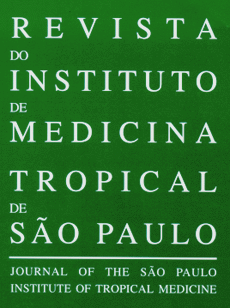CORRESPONDENCE/AUTHORS' REPLY
It is unlikely that statistical power or confounding can fully explain the lack of benefit of introducing penicillin at a late stage of leptospirosis
Ref.: Penicillin at the late stage of leptospirosis: a randomized controlled trial
August 14, 2003
Sir:
We would like to clarify the questions raised by Dr. Leblebicioglu. Even though the sample size (253 patients) of our study1 is the greatest among all published clinical trials developed to test the effect of antimicrobial treatment for patients with leptospirosis the influence of statistical power on the results cannot be denied. Our sample size calculation was in fact based on a one-tailed hypothesis because we did not expect to find a worse result in patients on penicillin. To test a one-sided hypothesis for a type 1 error of 5% and a power of 80% we would need approximately 237 patients in each group to find a significant relative risk reduction of 50% in patients on penicillin, assuming a baseline mortality risk of 14%. However, in the description of our results we used a more conventional decision rule for statistical significance, i.e., a two-sided p value of 0.05 and a 95% confidence interval (CI). As reported the observed difference in the risk of death pointed in the opposite direction of the study hypothesis, suggesting no benefit or poorer prognosis with penicillin treatment. The lower and upper limits of the 95% CI of the adjusted odds ratio (OR) were 0.78 and 4.80, respectively. Thus, we are 95% sure that if penicillin is beneficial for patients with leptospirosis the associated reduction in the odds of death is no more than 22%. On the other hand the upper limit of the 95% CI indicates an increase in the odds of death associated with penicillin of 380% (OR = 4.80). We are also 90% sure that the reduction in the odds should not be greater than 10% since the lower limit of the 90% CI of the adjusted OR was 0.90. Thus, it is very unlikely that the continuation of the trial to increase the sample size would revert the association in the direction of a significant beneficial effect of penicillin. Our findings are in fact consistent with the results of previous studies that have also shown evidence that penicillin is not beneficial for patients with severe or late stage leptospirosis2,3.
Regarding thrombocytopenia and renal failure, as expected, we found that both variables were significantly associated with higher odds of death; however, the distribution of these variables was similar between the penicillin and the control group. In fact the only potential risk factor of death included in the analysis that differed significantly between the treatment groups was leukocyte count and for that reason our analysis was adjusted for that variable. Thus, it is also unlikely that confounders may explain the difference between the groups.
We completely agree with Dr. Leblebicioglu that antimicrobial therapy is not the only factor that influences the prognosis of leptospirosis. Adjuvant therapy to fluid and electrolyte disturbances and the use dialysis are also important. In our study, however, the same treatment protocol was used for all patients, except for the tested intervention, i.e., penicillin. Dialysis was used for 58 of the 253 patients, a frequency that is not significantly different (p > 0.1) from the one reported by Dr. Leblebicioglu. However, we observed a higher frequency of dialysis for patients on penicillin therapy (28% vs 18%, p = 0.06). Considering that the levels of urea, creatinine and potassium were not different between the two treatment groups at admission we concluded that likely the patients on penicillin had a higher incidence of complications requiring dialysis in addition to a higher, although not significant, risk of death. We could not assess which substantive factors might have contributed to a lack of benefit of penicillin among our patients. It has been described, however, that the clinical manifestations of leptospirosis may worse in some patients after the initiation of antibiotic therapy due to the development of Jarisch-Herxheimer reaction4.
Antonio Alberto LOPES
Faculdade de Medicina da Universidade Federal da Bahia (UFBA) and
Núcleo de Epidemiologia Clínica do Hospital Universitário Professor Edgard Santos
Rua Mar. Floriano 448 apt 1301, Canela,
40110-010 Salvador, BA, Brasil.
Fax: 55.71.213-6710. E-mail: aaslopes@ufba.br
Everaldo COSTA
Escola Bahiana de Medicina e Saúde Pública and
Hospital Couto Maia, Salvador, BA, Brasil
REFERENCES
1. COSTA, E.; LOPES, A.A.; SACRAMENTO, E. et al. - Penicillin at the late stage of leptospirosis: a randomized controlled trial. Rev. Inst. Med. trop. S. Paulo, 45: 141-145, 2003.
2. DAHER, E.F. & NOGUEIRA, C.B. - Evaluation of penicillin therapy in patients with leptospirosis and acute renal failure. Rev. Inst. Med. trop. S. Paulo, 42: 327-332, 2000.
3. EDWARDS, C.N.; NICHOLSON, G.D.; HASSELL, T.A.; EVERARD, C.O. & CALLENDER, J. - Penicillin therapy in icteric leptospirosis. Amer. J. trop. Med. Hyg., 39: 388-390, 1988.
4. VAUGHAN, C.; CRONIN, C.C.; WALSH, E.K. & WHELTON, M. - The Jarisch-Herxheimer reaction in leptospirosis. Postgrad. med. J., 70: 118-121, 1994.
Publication Dates
-
Publication in this collection
17 Sept 2003 -
Date of issue
Aug 2003

